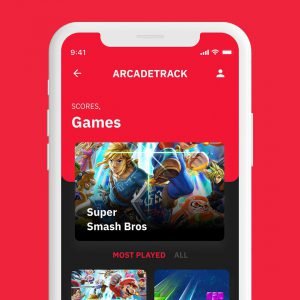UX design
ArcadeTrack Case Study
The designer is a transcriber, a translator of user goals and interests in a new, clear and legible form.
- Role UX Designer, Visual Designer
- Date H1 March 2021
- Type UX design

- Challenge
Make arcades and scores relevant again
Solution
Create a tool to socialize and make leaderboards challenging and legit.

Research
Design has to focus first-and-foremost on user research in order to be sure to keep the user first and center throughout the whole process. I first tried to understand how to make arcades interesting again. Remote interviews lead us to develop two different personas.
Understand what kind of players used to play games at the arcade.
Understand, what aspects of arcade gaming the miss the most.
Figure out why these gamers stopped playing at the arcades.
Keep a complete picture of their current way of playing games now that many years have passed since the arcade-times.
User Personas
The first interviews were followed by an analysis aimed at synthesis. I developed two personas to identify the main clusters of players that used to play at the arcade. The main objective was to humanize them in order to emphasize them.

William Champ
Goals
- Reach the highest level of a competition
- Find new challenges in already mastered games
- Have fun while limiting frustration
Frustrations
- “It’s difficult to know if arcade records are reached by bots”
- “There’s no way for others to know who am I and if the same nickname on two arcade games still refers to me”
- Moving to other arcades, even if not far, makes me feel like losing my progress/highscores”

Robert Junior
Goals
- Experience videogames as he did when he was a kid
- Get to know new people with the same passion
- Take a break after work
Frustrations
- He’s really tired after work, and today’s video game seem much more complex and intimidating
- He’s afraid of finding only kids in arcade and not someone more relatable to him
- He’s not sure if there still are people going to arcades nowadays. Are they relevant?
First wireframes

Usability Research
Test first lo-fi prototype.
Goal: Determine if the user can add a new high score easily. Determine if the “rivals” feature is interesting or not.
How long does it take a user to add a score?
What can we learn from the way the user adds a score?
Is the app cumbersome to use while playing a game at an arcade?
Is the “Rival” feature an incentive to play more?

Design system
After developing the first lo-fi prototype, I determined a custom design system based on Google Material Design Guidelines, still while applying some of Apple Human Interface Guidelines principles. Shapes, color, typography, inputs, sliders, toggles and many more components were designed consistently.
IBM Plex Sans was chosen because of its modernist appearance and its inheritance to a digital experience. Headings and paragraphs were designed in a proportion of Major Third.
The main color palette aimed at conveying a sense of digital dynamism while maintaining attention to accessibility.

Hi-fi Protype. Research and Iterate.
I then developed the first high-definition prototype, which proved to be quite useful for many more design iterations founded on another usability research. Design should not stop at the first draft but always iterate.

Iteration is one of the core fundamentals of the design process. Usability tests let me understand where I was applying biases and how the main userflow could be improved.

In these examples, selection of the location has been made more accessible and the next button is always present (fixed) rather than being at the bottom of a long list.

Accessibility – What I learned
This project was actually an assignment for Google UX Certificate. I was unsure about the overall purpose since its brief was automatically generated by Shapen (sharpen.design, you should try it!). However after the first usability test I realised how great it was to work on something new without any ‘job constraint’ and focusing solely on the user, which should always be first and center.
Seeing real users testing my prototypes for the first time was really fascinating and made me realize how important the user is in the design process. The designer is not the only author of the design. Actually, it could be considered just a transcriber, a translator of user goals and interests in a new, clear and legible form. Therefore, Design has to be accessible and equitable.
